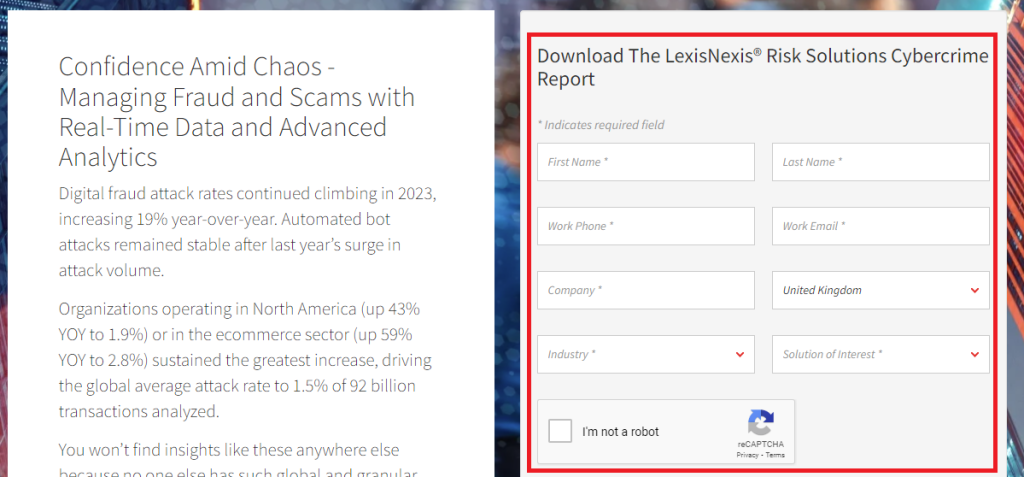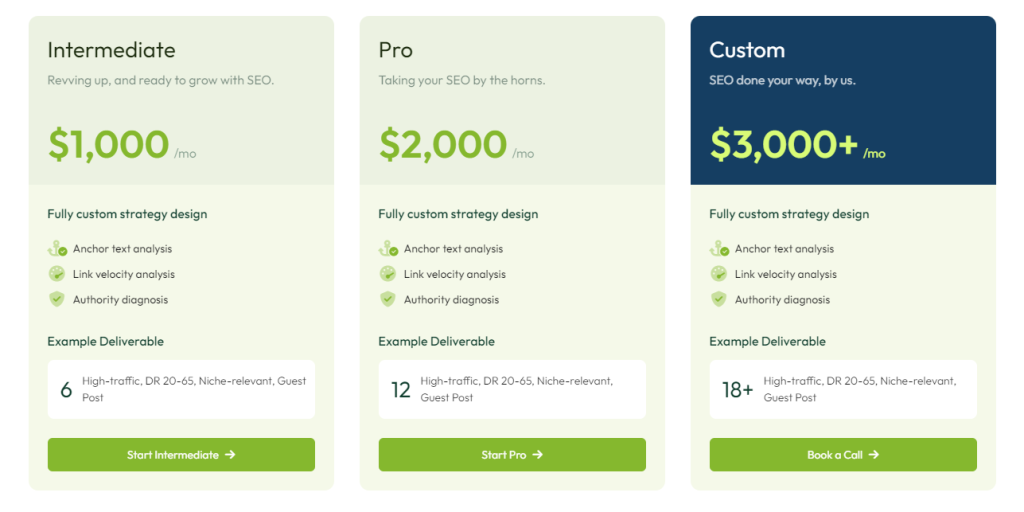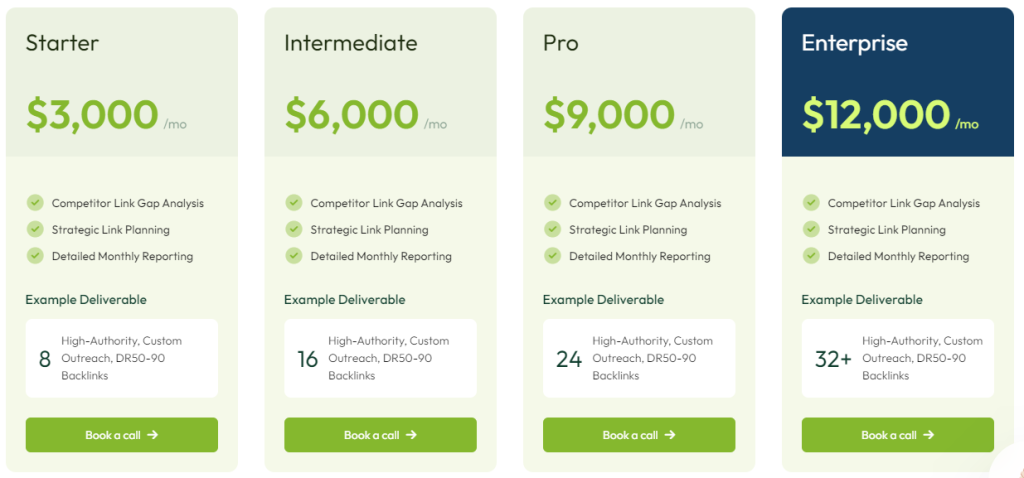
Do you run your own agency? Or are you a freelancer with a steady base of clients?
Selling SEO is a great way to expand your offering and make more revenue from the clients you already serve.
The problem is that providing SEO services requires deep knowledge and experience of what works.
Why?
Because if you get it wrong, your client’s rankings could be reduced to zero—not great for your relationship!
This article explains why you should sell SEO, what it is, and how to sell SEO.
Contents:
How Much Should I Charge for My SEO Services?
Get White-Label SEO Services from Authority Builders
Why Sell SEO?
Search engine optimization (SEO) is the process of ensuring websites rank as high as possible on platforms like Google.
It is a crucial part of digital marketing. It helps generate a steady stream of organic traffic to websites—which means more sales opportunities.
So it’s no surprise that companies are willing to spend A LOT of money to secure this traffic.
Let’s use an example to see the benefits it could offer your clients and what you could earn.
We’re going to look at HR software provider Deel. Its website has been active for about two years.
According to SEOleaders.com, the average monthly price of SEO services is $2,000.
Over two years that’s $48,000.
We don’t know that Deel has been using SEO services, but it seems likely given the company’s rapid increase in traffic.
In just two years, the company’s website has gone from 0 to more than 300,000 monthly visitors.

So what’s that increase in traffic worth for Deel?
If we assume a conversion rate of 2%, then Deel could expect 6,000 new customers per month.
Deel’s minimum plan costs $49 per month.
So 6,000 x $49 = $294,000
Over two years, that’s $7,056,000—or a 147x return on investment (ROI)!
You’ve just provided incredible value to your client!
Of course, we don’t know if all that traffic came from SEO, but even if a fraction of it did, it’s still impressive.
How much will you earn?
So how much of that $48,000 revenue over two years do you get to keep as profit?
It depends on how you structure your SEO services. There are four main options, each presenting different levels of effort and return:
- Use your existing resources
- Hire an SEO manager
- Use a freelancer
- Use an SEO agency
We don’t recommend you choose the first option. SEO requires a lot of effort and trying to fit it into your existing workflow could distract you from your core business. Plus, things could quickly go wrong if your employees don’t have solid SEO management experience. The good news, however, is you would get to keep most of the revenue.
The average SEO manager is paid around $76,660 per year. This means you’d need to significantly scale up your number of SEO clients to make a profit.
Freelancers tend to be more affordable at around $75–$100 per hour. However, they also require a lot of management. More importantly, finding a highly capable freelancer can be difficult. Many rely on poor-quality link-building techniques that prioritize quantity over quality. As a result, your client could end up with a ton of low-quality backlinks that won’t have a positive impact on their rankings.
Finally, there’s using an agency. If you’ve never provided SEO services before, then this is a great way to start out. The agency will handle all your SEO requirements, while you focus on running the rest of your business.
The downside is that the agency will take a big cut of your revenue—usually around 90%. However, you’ll be earning additional monthly income by doing almost nothing and building a reputation for providing high-quality, professional SEO services.
What are white-label SEO services?
Some SEO agencies provide white-label services. This is sometimes called SEO reselling.
This is when an SEO agency provides services on behalf of another company to a client. As far as the client can tell, the services are being provided by the intermediary company and not by the SEO agency.
All client interactions are done through you and everything you send them—including content, strategies, and monthly reports—have your branding on them.
Who Can Sell SEO?
In theory, anyone can sell SEO services.
However, some companies are better placed than others. They include:
📈 Marketing agencies: SEO is a subcategory of marketing. Companies that already provide these services could benefit from offering SEO services.
🌐 Web development agencies: SEO has some technical elements and it is focused on a company’s website; therefore, it sometimes makes sense for some web development businesses to offer these services.
👨🏻💼 Freelancers: If you are a successful freelancer in either of the above fields and you have an extensive roster of clients, then you may wish to add SEO to your list of services.
What Does SEO Consist Of?
By now, you would have realized that selling SEO is worthwhile and you should have a better idea of your options for providing the service.
Next, you need to understand what you are selling.
If you’re going to manage SEO yourself, then you need to be an expert.
However, if you’re going to hand most of the work over to an agency, you just need to understand the basics so you can have an informed conversation with your clients.
This section introduces you to some of those basic concepts.
SEO consists of four main “pillars.” These are the elements of your clients’ websites you need to optimize to help them rise in the search engine results pages (SERPs).
These pillars are:
- On-site SEO
- Technical SEO
- High-quality content
- Off-site SEO
Let’s look at what each one involves.
On-site SEO
These are the optimizations you perform on individual pages that help search engines understand what your client’s web pages are about and show them to the right people.
This is mainly achieved by placing keywords in the correct places.
A keyword is simply a term that search engines recognize as being relevant to your client’s website.
For example, let’s say someone searches for “holiday villas in Spain” and Google sees that the keywords on your client’s website are things like:
- Software provider
- Tech solutions
- Site architecture
- Developer California
It won’t even consider your website—and rightly so, it’s not relevant.
But you’d stand a much better chance if someone typed in web developer, San Diego.
Other on-page SEO elements that get optimized include:
URLs: In other words, the web address you type to reach the page. It should be short, simple, descriptive, and include relevant keywords.

Title tags: This is the big blue text shown on the SERPs. These tags should be clear, descriptive, and include the main keyword. It’s often a good idea to include your brand name, too.

Meta descriptions: This is the descriptive text under the title tag. It should encourage the reader to click the link and should not exceed 160 characters.
Header tags: These are the “headings” you see when reading a page. They are given labels that reflect information hierarchy. So H1 is your main title, H2s are subtitles, and H3s and H4s introduce further subsections. These headings help search engines and users understand and navigate your content.

Technical SEO
While users can see most elements of on-page SEO, most elements of technical SEO happen behind the scenes. However, they are still critical for improving the user experience and SEO.
Key technical SEO elements include:
Site speed: How fast the pages of your clients’ websites load not only affects the user experience, but also how high search engines rank them.
Factors that impact page load speed include:
- The size of any images or files hosted there.
- Page redirects.
- Any plugins that your client might be using.
Optimized for mobile: Search engines understand that about 80% of searches are carried out on mobile devices. Trying to view a website that is designed only for desktop computers on a smartphone is frustrating. Therefore, platforms like Google prefer websites that are optimized for different devices.
Site structure: Having a well-organized site that’s easy to navigate and has clear hubs is crucial. Not only does it make it easier for users to find what they need, but it also makes it easier for Google to find new content when your client adds it.
If your client’s site isn’t well organized, then search engines might struggle to find your new content or might struggle to understand what it represents. If this happens, then it won’t be able to show it in the SERPs.
Some of the things a good site structure will have, include:
- No broken links.
- Short menus.
- Links consisting of relevant text and keywords.
- A sitemap to help search engines quickly explore your site.
High-quality content
When search engines look for pages that answer search queries they will consider the information on the page. They will also decide whether they trust that website to provide good information.
Let’s say someone searches for the term “holiday villas in Spain.”
Your client’s website is full of high-quality, rich, relevant and detailed information on the best holiday villas in Spain. It also includes reviews, a map users can use to locate accommodation, and a booking app.
Google is more likely to show that website to users than one with a handful of text-only reviews of holiday villas across Europe.
Why?
Because the information on your client’s website is more relevant, exhaustive, and useful for readers. It also displays your client’s extensive knowledge.
Having a website full of high-quality content like this helps fulfill four main requirements that Google uses to determine the quality of pages which, in turn, are used to decide their ranking.
They are:
- Experience: You demonstrate first-hand experience of the subject you cover.
- Expertise: You can provide expert-level information on the subject.
- Authoritativeness: You consistently publish content on the subject that gets shared by people online.
- Trustworthiness: Users know who runs your website and who has created the content. You are a real company that readers can get in touch with.
Together, these requirements are known as EEAT.
One of the ways to improve your EEAT is to have a strategy for regularly publishing high-quality content.
This involves:
Performing keyword research: Look for keywords that are relevant to your client’s target audience and attract high search volumes.
Thinking about search intent: Long-tail keywords help indicate what information your client’s readers are looking for. For example, people searching for “how to choose a laptop” are probably looking for information, while people searching “best laptops” want to make a purchase. Make sure your content addresses users’ needs.
Writing quality content: Hire professional writers to create articles around your chosen keywords and publish them on your blog. Ensure that they are original and provide value to readers.
Creating hubs: You should group your content into broad categories known as hubs. For example, if your client sells women’s fashion, then you might have hubs for shoes, accessories, jeans, and dresses. These hubs help search engines understand what your website is about and identify the different areas you have expertise in.
Off-page SEO
As mentioned in the previous section, authority is an important part of SEO.
Search engines measure this by looking at the number of times people link to your content.
The idea is that people do this because they think your content is good. So the more people who do this, the better your content must be.
The number of domains that link to your client’s website is a critical factor in how high it ranks in search.
Of course, it’s more complicated than this. The following factors all have an impact on your website authority:
- The authority of linking domains
- The relevance of linking domains and pages to your content
- The relevance of linking anchor text
- The source of the link—for example, social media links are usually considered less valuable than links in blog content.
Link building is in itself a subsection of SEO. Common techniques that are used include:
Guest posting: Agreeing with other website owners to write content for their blog and including a link to your site in it.
Broken link building: Finding links to pages that no longer exist and offering to replace the missing content.
Link insertions: Contacting site owners and asking that a link to your website be added to their content.
Linkable assets: Creating something so good or useful that it naturally attracts high authority backlinks over time.
Resource or stats pages: Curating lists of useful resources and information in one convenient place, from where people in your industry can easily share them.
How to Get Set Up Selling SEO
Now that you understand the basics of what SEO is all about, here are some tips for selling it.
Target the right customers
SEO isn’t for every business. For example, if a prospect makes sales via personal relationships, then converting customers only using online channels may be challenging.
Qualifying your prospects is critical. You need to find customers that have a burning need for SEO. It has to be clear to you and to them how they can use SEO to meet their goals.
You also need to be able to provide the client with quality services. For example, if they work in a very technical field and want to write a large number of articles, then you may struggle to find knowledgeable writers in this niche.
Use an inbound funnel
Inbound funnels are when leads come to you. You achieve this with your own marketing channels, such as social media, events, and—you guessed it—SEO.
There are four stages to any inbound funnel:
- Awareness
- Interest
- Consideration
- Purchase
Let’s look at each one in detail.
Awareness
As the name suggests, this is where the customer first becomes aware of your brand.
At this stage, you should not suggest they buy your SEO services. Instead, try to gain their trust.
This way, when you do ask them to buy our services, they will know who you are and why they should trust you.
One of the best ways to do this is by providing them with something valuable.
Here’s an example of a useful article from LexisNexis on anti-money-laundering services. The article explains two different risk models that can be used in risk mitigation strategies.

Giving this useful information away for free shows their expertise and solidifies their brand in their target audience’s minds.
When selling SEO, you could provide a blog article providing beginner SEO tips or something similar.
Interest
Next, you need to get prospects to self-qualify themselves by registering their interest.
LexisNexis does this, too. The company has commissioned some original research on cybercrime. However, to access the full report you need to enter your details, including your email address.

By doing so, LexisNexis has gathered the contact details of people who are interested in their services. They can now target these people and move them to the next stage of the marketing funnel.
Consideration
This is where you present your services to prospects—but in a way that helps them understand how it can solve their problems.
Webinars are a great way to do this. You can invite them to a session where you promise to solve an issue that they are facing—for example, how to increase their online sales.
You can, for example, ask a client to join you on the webinar and show how you are able to help them solve this issue using SEO.
You can then field questions from your prospect at the end. Best of all, this allows you to meet your prospect (albeit online) so they know you personally. You can now follow up with a phone call asking whether they have any questions and they will know who you are.
Here’s an (audio-only) example from app platform Fliplet. Most of the webinar explains how their solution helped a law firm scale its tech team. However, at the end the host goes into detail about their solution.
Purchase
Let’s say you phoned a prospect who attended your webinar and you answered their questions.
Take the time to ask them questions, too. Try to understand their business goals and determine whether your SEO services can help them achieve them.
If they are interested, then it’s time to make a sale.
Ask them who at their business has the authority to approve buying your services. Ask whether you can meet them to explain how you can help them meet their goals.
When you attend the presentation try to understand what the decision-maker wants to achieve. It could differ from that of your initial contact. Try to connect their goals with your solution.
Show results
Remember that graph we showed at the start of the article? SEO is all about metrics, so graphs are a great way to show how your SEO services have benefited clients at a glance.
An SEO tool like Ahrefs can be useful here. It allows you to bring up different website and search metrics.
Not only can you show what you have achieved for clients, you can also show the scale of the opportunity.
For example, this overview of the keyword “what is tax accounting” shows:
- How many people search for it each month.
- What that’s worth in terms of pay-per-click advertising.
- How easy it is to rank for this term.

You can also find out which websites rank for this term, how authoritative they are, and what other associated keywords you might be able to target.
This can get clients thinking about the potential ways they could benefit from SEO.
Use testimonials
The passive nature of SEO marketing means that some business leaders struggle to see how it can lead to revenue.
One way to convince them is using case studies of your other clients’ success. Video case studies are particularly convincing.
That’s because:
- It proves the client is a real person.
- It shows how happy they are.
- They are better at explaining the challenges you helped overcome.
- The fact that they have taken the time to compile a case study shows their goodwill toward you.
You can see how we do this on our case studies page.
🤔 How Much Should I Charge for My SEO Services?
As mentioned earlier, the average cost of SEO services is around $2,000 per month.
But what you charge will depend on a number of factors, including:
- What your customers can afford to pay.
- The scope of service you provide.
- Your overheads.
- Regional factors (for example, the cost of living in your country).
- Your brand recognition.
For example, if you are using a white-label service, the only overhead you pay is the monthly agency fee. You could charge a mark-up on the agency’s pricing while you build a reputation for SEO. Once you have a decent number of clients, you could begin to charge slightly more due to your strong reputation.
The level of service also makes a difference.
For example, here at Authority Builders, we offer three packages that include our standard ABC Plus service:

And four packages that include our ABC Platinum service:

Catering to companies with different budgets is a good way of making your services affordable.
Get White-Label SEO Services from Authority Builders
Learning how to sell your SEO services can be challenging.
But finding a way to provide them isn’t and there are many options available, from hiring freelancers to white labelling.
At Authority Builders we work with a range of agencies, providing them with third-party SEO services.
This includes:
- Backlink and SEO audits
- Strategy Advice
- Content creation
- Guest posting
- Digital PR
- Citations
- Reporting
We work behind the scenes providing high-quality white-label SEO services that you can be proud of. This allows you to offer scalable, professional SEO services with minimal effort. Book a call to learn more.

